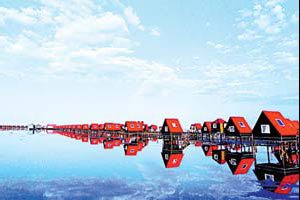 |
|
Re-enactment of a royal ritual from the Qing Dynasty.
|
For decades the name Tangshan rekindled painful memories of a severe earthquake that devastated the city in 1976.
Yet Tangshan has risen like a phoenix from the ruins as a new tourist destination attracting visitors with its well-preserved cultural sites and nature.
In the south of the 13,472 sq km city are a cluster of islands covered in forest with soft sandy beaches and diverse bird species.
Stretches of the ancient Great Wall meander through its northern mountains, still standing after centuries and the 1976 disaster.
The short distance that separates Beijing and the coastal city of 7.19 million people is expected to provide a boon to tourism during the Olympics.
Imperial tombs
 |
|
Touist guesthouses on Yuetuo Island.
|
An hour-and-a-half's drive east of Beijing visitors come to the largest royal tomb complex in China
– Qingdongling, the eastern imperial tombs of the Qing Dynasty (1644-1911).
Surrounded by mountains, construction on the tombs started in 1661.
Covering 78 sq km, 15 impressive tombs hold the remains of 161 royal family members, including five emperors, 15 empresses, 136 imperial concubines, three princes and two princesses.
Emperors entombed at Qingdongling include Shunzhi, the first Manchu emperor to rule all of China, Kangxi, considered one of the greatest emperors in Chinese history who began an age of prosperity, and Qianlong, during whose reign the dynasty reached its golden age.